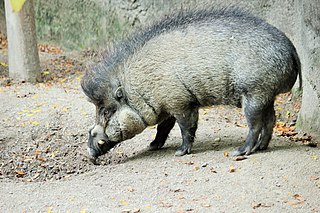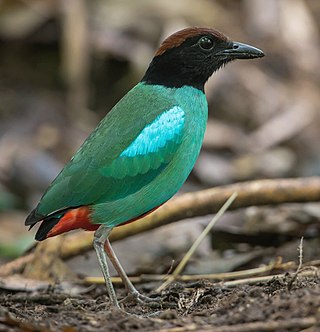
Tawi-Tawi, officially the Province of Tawi-Tawi, is an island province in the Philippines located in the Bangsamoro Autonomous Region in Muslim Mindanao (BARMM). The capital of Tawi-Tawi is Bongao.

The Sunda stink badger, also called the Javan stink badger, teledu, Malay stink badger, Malay badger, Indonesian stink badger and Sunda skunk, is a mammal native to Indonesia and Malaysia. Despite the common name, stink badgers are not closely related to true badgers, and are, instead, Old World relatives of the skunks. Coincidentally, its local name sigung in Sundanese is a false cognate to skunk which is of Algonquian origin.

The Malayan tiger is a tiger from a specific population of the Panthera tigris tigris subspecies that is native to Peninsular Malaysia. This population inhabits the southern and central parts of the Malay Peninsula and has been classified as nationally critically endangered. As of April 2014, the population was estimated at 80 to 120 mature individuals with a continuous declining trend.

The Borneo elephant, also called the Bornean elephant or the Borneo pygmy elephant, is a subspecies of Asian elephant (Elephas maximus) that inhabits northeastern Borneo, in Indonesia and Malaysia. Its origin remains the subject of debate. A definitive subspecific classification as Elephas maximus borneensis awaits a detailed range-wide morphometric and genetic study. Since 1986, the Asian elephant has been listed as Endangered on the IUCN Red List as the population has declined by at least 50% over the last three generations, estimated to be 60–75 years. It is pre-eminently threatened by loss, degradation and fragmentation of habitat.

The Visayan warty pig is a critically endangered species in the pig genus (Sus). It is endemic to six of the Visayan Islands in the central Philippines. It is known by many names in the region with most translating into 'wild pig': baboy ihalas, baboy talonon, baboy sulop, and baboy ramo.

The western hooded pitta is a passerine bird in the family Pittidae. It is common in eastern and southeastern Asia and maritime Southeast Asia, where it lives in several types of forests as well as on plantations and other cultivated areas. It is a green bird with a black head and chestnut crown. It forages on the ground for insects and their larvae, and also eats berries. It breeds between February and August, the pair being strongly territorial and building their nest on the ground. Incubation and care of the fledglings is done by both parents. The bird has a wide range, and the International Union for Conservation of Nature has assessed its conservation status as being of "least concern". It was formerly considered to be conspecific with the Nicobar hooded pitta, the Minahasa hooded pitta, the eastern hooded pitta and the Biak hooded pitta.

The lesser coucal is a species of cuckoo in the family Cuculidae. It has a wide distribution range that overlaps with several other similar species. The habitat in which it is found is often marshy land with grass and tree cover. It is distinguished by its smaller size, less prominent bill, pale shaft streaks on the feathers of the head and back. It has a much longer claw on its hind toe and a distinct call. It is also among the few coucals that show season plumage differences but like in other coucals, the sexes cannot be distinguished in the field.

The yellow-bellied bulbul is a species of songbird in the bulbul family, Pycnonotidae. It is found on the Malay Peninsula, Sumatra and Borneo. Its natural habitat is subtropical or tropical moist lowland forests.

Low's squirrel is a species of rodent in the family Sciuridae. It is found in Borneo and nearby islets. Its former subspecies S. l. robinsoni from Sumatra and the Malay Peninsula and S. l. natunensis from the Natuna islands have recently been given species status.

The Malayan weasel or Malay weasel is a weasel species native to the Malay Peninsula and the islands of Sumatra and Borneo. It is listed as Least Concern on the IUCN Red List.
Bearded pig may refer to:
The Philippines has four endemic types of species of wild pigs. This makes the Philippines unique in having arguably the largest number of endemic wild pigs. Two separate populations of unstudied wild pig species have been reported on the islands of Tawi-Tawi, and Tablas.

The Borneo lowland rain forests is an ecoregion, within the tropical and subtropical moist broadleaf forests biome, of the large island of Borneo in Southeast Asia. It supports approximately 15,000 plant species, 380 bird species and several mammal species. The Borneo lowland rain forests is diminishing due to logging, hunting and conversion to commercial land use.

Tanjung Puting National Park is a national park in Indonesia located in the southeast part of West Kotawaringin Regency in the Indonesian province of Central Kalimantan. The nearest main town is the capital of the Regency, Pangkalan Bun. The park is famous for its orangutan conservation.

The Palawan bearded pig is a pig species in the genus Sus endemic to the Philippines, where it occurs on the archipelago of islands formed by Balabac, Palawan, and the Calamian Islands. It is 1 to 1.6 m in length, about 1 m (3.3 ft) tall and weigh up to 150 kg (330 lb).

The Philippine slow loris is a strepsirrhine primate and a species of slow loris that is native to the north and east coastal areas of the island of Borneo, as well as the Sulu Archipelago in the Philippines. The species was first named as the Bornean slow loris in 1892, but lumped into the widespread Sunda slow loris (N. coucang) in 1952. However, it was promoted to full species status – again as the Bornean slow loris – based on molecular analysis in 2006. In 2013, two former subspecies of the Bornean slow loris were elevated to species status, and a new species—N. kayan—was recognized among the Bornean population.

Wong Siew Te is a Malaysian wildlife biologist known for his studies on the Malayan sun bear and the foundation of the Bornean Sun Bear Conservation Centre in Sandakan, Sabah.





















